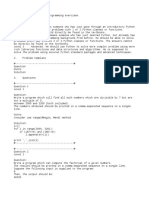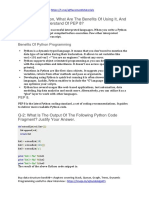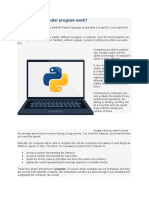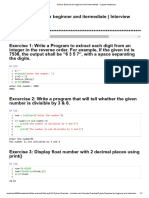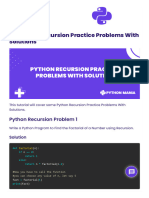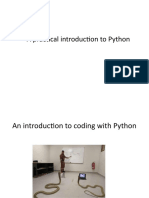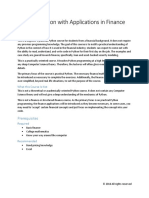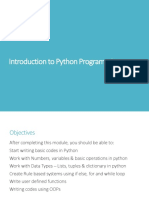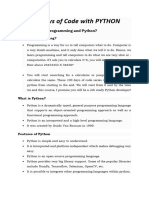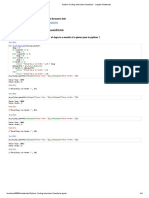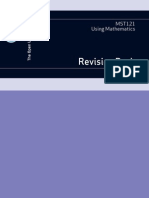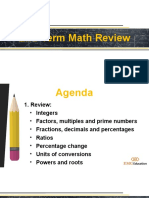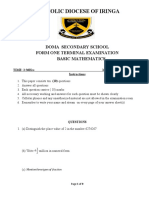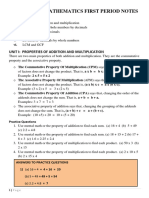Python Interview Q/A & Case studies
Here’s what you’ll find in this document:-
● Python Libraries Case studies
● Python Programming Interview Q/A
Python Libraries Case studies
Below Playlist Contains more than 20 Python EDA Case studies videos-
- https://youtube.com/playlist?list=PL_1pt6K-CLoDMEbYy2PcZuITWEjqMfyoA
Python Programming Interview Q/A
Question 1: Write a Python program to Reverse a String.
Solution:
With Indexing:
def reverse_string(s):
return s[::-1]
Example usage
input_string = "Hello, World!"
reversed_string = reverse_string(input_string)
print("Original string:", input_string)
print("Reversed string:", reversed_string)
Output:
Original string: Hello, World!
Reversed string: !dlroW ,olleH
Without Indexing:
def reverse_string(s):
reversed_str = ""
for char in s:
reversed_str = char + reversed_str
return reversed_str
Example usage
input_string = "Hello, World!"
reversed_string = reverse_string(input_string)
print("Original string:", input_string)
print("Reversed string:", reversed_string)
Output:
Original string: Hello, World!
Reversed string: !dlroW ,olleH
Question 2: Write a Python program to Check Palindrome.
Solution:
For String:
def is_palindrome(s):
s = s.replace(" ", "").lower()
return s == s[::-1]
Example usage
input_string = "A man, a plan, a canal, Panama"
if is_palindrome(input_string):
print("The string is a palindrome.")
else:
print("The string is not a palindrome.")
Output:
The string is a palindrome.
For Number:
def is_palindrome(number):
num_str = str(number)
return num_str == num_str[::-1]
Example usage
input_number = 12321
if is_palindrome(input_number):
print("The number is a palindrome.")
else:
print("The number is not a palindrome.")
Output:
The number is a palindrome.
Question 3: Write a Python program to Count Vowels in a String.
Solution:
def count_vowels(s):
vowels = "aeiouAEIOU"
count = 0
for char in s:
if char in vowels:
count += 1
return count
Example usage
input_string = "Hello, World!"
vowel_count = count_vowels(input_string)
print("Number of vowels in the string:", vowel_count)
Output:
Number of vowels in the string: 3
Question 4: Write a Python program to find Factorial with Recursion.
Solution:
With Function:
def factorial(n):
if n == 0:
return 1
else:
return n * factorial(n - 1)
Example usage
number = 5
result = factorial(number)
print("Factorial of", number, "is", result)
Output:
Factorial of 5 is 120
Without Function:
number = 5
factorial = 1
if number < 0:
print("Factorial is not defined for negative numbers.")
elif number == 0:
print("Factorial of 0 is 1")
else:
for i in range(1, number + 1):
factorial *= i
print("Factorial of", number, "is", factorial)
Output:
Factorial of 5 is 120
Question 5: Write a Python program to find Fibonacci Sequence.
Solution:
def fibonacci(n):
fib_sequence = [0, 1]
for i in range(2, n):
next_term = fib_sequence[-1] + fib_sequence[-2]
fib_sequence.append(next_term)
return fib_sequence
Example usage
num_terms = 10
fib_sequence = fibonacci(num_terms)
print("Fibonacci sequence up to", num_terms, "terms:", fib_sequence)
Output:
Fibonacci sequence up to 10 terms: [0, 1, 1, 2, 3, 5, 8, 13, 21, 34]
Question 6: Write a Python program to find the Maximum Element in a List.
Solution:
Using Built-in Function:
my_list = [10, 23, 45, 67, 12, 89, 34]
max_element = max(my_list)
print("Maximum element in the list:", max_element)
Output:
Maximum element in the list: 89
Using User-defined Function:
def find_max_element(lst):
if not lst:
return None
max_element = lst[0]
for num in lst:
if num > max_element:
max_element = num
return max_element
Example usage
my_list = [10, 23, 45, 67, 12, 89, 34]
max_element = find_max_element(my_list)
print("Maximum element in the list:", max_element)
Output:
Maximum element in the list: 89
Here is the continuation of the Python interview questions and answers in the
requested format:
Question 7: Write a Python program to find Anagram Check.
Solution:
def is_anagram(str1, str2):
str1 = str1.replace(" ", "").lower()
str2 = str2.replace(" ", "").lower()
return sorted(str1) == sorted(str2)
Example usage
string1 = "listen"
string2 = "silent"
if is_anagram(string1, string2):
print(f"'{string1}' and '{string2}' are anagrams.")
else:
print(f"'{string1}' and '{string2}' are not anagrams.")
Output:
'listen' and 'silent' are anagrams.
Question 8: Write a Python program to find Prime Numbers.
Solution:
def is_prime(num):
if num <= 1:
return False
for i in range(2, int(num ** 0.5) + 1):
if num % i == 0:
return False
return True
def find_primes(start, end):
primes = []
for num in range(start, end + 1):
if is_prime(num):
primes.append(num)
return primes
Example usage
start_range = 1
end_range = 50
prime_numbers = find_primes(start_range, end_range)
print("Prime numbers between", start_range, "and", end_range, "are:",
prime_numbers)
Output:
Prime numbers between 1 and 50 are: [2, 3, 5, 7, 11, 13, 17, 19, 23, 29, 31, 37,
41, 43, 47]
Question 9: Write a Python program to check for Pangram.
Solution:
import string
def is_pangram(sentence):
sentence = sentence.lower()
unique_chars = set(sentence)
unique_chars.difference_update(set(string.punctuation + " "))
return len(unique_chars) == 26
Example usage
input_sentence = "The quick brown fox jumps over the lazy dog"
if is_pangram(input_sentence):
print("The sentence is a pangram.")
else:
print("The sentence is not a pangram.")
Output:
The sentence is a pangram.
Question 10: Write a Python program for basic Data Structure Operations
(e.g., list manipulation, string manipulation).
Solution:
List Manipulation
my_list = [1, 2, 3, 4, 5]
Append an element to the list
my_list.append(6)
print("After appending 6:", my_list)
Remove an element from the list
my_list.remove(3)
print("After removing 3:", my_list)
Access elements by index
print("Element at index 2:", my_list[2])
String Manipulation
my_string = "Hello, World!"
Split the string into a list of words
words = my_string.split()
print("Split string into words:", words)
Join elements of a list into a single string
new_string = "-".join(words)
print("Joined words with '-':", new_string)
Convert string to uppercase
upper_string = my_string.upper()
print("Uppercase string:", upper_string)
Replace a substring
replaced_string = my_string.replace("World", "Universe")
print("After replacing 'World' with 'Universe':", replaced_string)
Output:
After appending 6: [1, 2, 3, 4, 5, 6]
After removing 3: [1, 2, 4, 5, 6]
Element at index 2: 4
Split string into words: ['Hello,', 'World!']
Joined words with '-': Hello,-World!
Uppercase string: HELLO, WORLD!
After replacing 'World' with 'Universe': Hello, Universe!
Question 11: Write a Python program to find the Minimum Element in a List.
Solution:
Using User-defined Function:
def find_min_element(lst):
if not lst:
return None
min_element = lst[0]
for num in lst:
if num < min_element:
min_element = num
return min_element
Example usage
my_list = [10, 23, 45, 67, 12, 89, 34]
min_element = find_min_element(my_list)
print("Minimum element in the list:", min_element)
Output:
Minimum element in the list: 10
Using Built-in Function:
my_list = [10, 23, 45, 67, 12, 89, 34]
min_element = min(my_list)
print("Minimum element in the list:", min_element)
Output:
Minimum element in the list: 10
Question 12: Write a Python program to calculate the Sum of Digits in a
Number.
Solution:
def sum_of_digits(number):
num_str = str(number)
digit_sum = 0
for digit in num_str:
digit_sum += int(digit)
return digit_sum
Example usage
input_number = 12345
result = sum_of_digits(input_number)
print("Sum of digits in", input_number, "is", result)
Output:
Sum of digits in 12345 is 15
Question 13: Write a Python program to check for Armstrong Number.
Solution:
def is_armstrong(number):
num_str = str(number)
num_digits = len(num_str)
armstrong_sum = 0
for digit in num_str:
armstrong_sum += int(digit) ** num_digits
return armstrong_sum == number
Example usage
input_number = 153
if is_armstrong(input_number):
print(input_number, "is an Armstrong number.")
else:
print(input_number, "is not an Armstrong number.")
Output:
153 is an Armstrong number.
Question 14: Write a Python program to check for Leap Year.
Solution:
def is_leap_year(year):
if (year % 4 == 0 and year % 100 != 0) or (year % 400 == 0):
return True
else:
return False
Example usage
input_year = 2024
if is_leap_year(input_year):
print(input_year, "is a leap year.")
else:
print(input_year, "is not a leap year.")
Output:
2024 is a leap year.
Question 15: Write a Python program to calculate Factorial without
Recursion.
Solution:
def factorial(n):
result = 1
for i in range(1, n + 1):
result *= i
return result
Example usage
number = 5
result = factorial(number)
print("Factorial of", number, "is", result)
Output:
Factorial of 5 is 120
Question 16: Write a Python program to find the Average of Numbers in a
List.
Solution:
def find_average(numbers):
if not numbers:
return None
total = sum(numbers)
average = total / len(numbers)
return average
Example usage
number_list = [10, 20, 30, 40, 50]
average = find_average(number_list)
if average is not None:
print("Average of numbers in the list:", average)
else:
print("The list is empty.")
Output:
Average of numbers in the list: 30.0
Question 17: Write a Python program to Merge Two Sorted Lists.
Solution:
def merge_sorted_lists(list1, list2):
merged_list = []
i=j=0
while i < len(list1) and j < len(list2):
if list1[i] < list2[j]:
merged_list.append(list1[i])
i += 1
else:
merged_list.append(list2[j])
j += 1
while i < len(list1):
merged_list.append(list1[i])
i += 1
while j < len(list2):
merged_list.append(list2[j])
j += 1
return merged_list
Example usage
list1 = [1, 3, 5, 7, 9]
list2 = [2, 4, 6, 8, 10]
merged_list = merge_sorted_lists(list1, list2)
print("Merged sorted list:", merged_list)
Output:
Merged sorted list: [1, 2, 3, 4, 5, 6, 7, 8, 9, 10]
Question 18: Write a Python program to Remove Duplicates from a String.
Solution:
def remove_duplicates(input_string):
unique_chars = set()
result = ""
for char in input_string:
if char not in unique_chars:
result += char
unique_chars.add(char)
return result
Example usage
input_string = "hello world"
result = remove_duplicates(input_string)
print("String with duplicates removed:", result)
Output:
String with duplicates removed: helo wrd
Question 19: Write a Python program to Check for Perfect Numbers.
Solution:
def is_perfect_number(number):
if number <= 0:
return False
divisor_sum = 0
for i in range(1, number):
if number % i == 0:
divisor_sum += i
return divisor_sum == number
Example usage
input_number = 28
if is_perfect_number(input_number):
print(input_number, "is a perfect number.")
else:
print(input_number, "is not a perfect number.")
Output:
28 is a perfect number.
Question 20: Write a Python program to Find the Maximum Difference
between Two Elements in a List.
Solution:
def max_difference(nums):
if len(nums) < 2:
return None
min_element = float('inf')
max_difference = float('-inf')
for num in nums:
min_element = min(min_element, num)
max_difference = max(max_difference, num - min_element)
return max_difference
Example usage
numbers = [7, 1, 5, 3, 6, 4]
result = max_difference(numbers)
if result is not None:
print("Maximum difference between two elements in the list:", result)
else:
print("The list has less than two elements.")
Output:
Maximum difference between two elements in the list: 5
Question 21: Write a Python program to check if a Number is Even or Odd.
Solution:
With User-defined Function:
def check_even_odd(number):
if number % 2 == 0:
return "Even"
else:
return "Odd"
Example usage
input_number = 7
result = check_even_odd(input_number)
print(input_number, "is", result)
Output:
7 is Odd
Without Function:
number = 7
if number % 2 == 0:
print(number, "is Even")
else:
print(number, "is Odd")
Output:
7 is Odd
Question 22: Write a Python program to Count Words in a Sentence.
Solution:
def count_words(sentence):
words = sentence.split()
return len(words)
Example usage
input_sentence = "This is a sample sentence."
word_count = count_words(input_sentence)
print("Number of words in the sentence:", word_count)
Output:
Number of words in the sentence: 5
With Built-in Function:
sentence = "This is a sample sentence."
word_count = len(sentence.split())
print("Number of words in the sentence:", word_count)
Output:
Number of words in the sentence: 5
Question 23: Write a Python program to Convert Decimal to Binary.
Solution:
def decimal_to_binary(decimal):
binary = ""
quotient = decimal
while quotient > 0:
remainder = quotient % 2
binary = str(remainder) + binary
quotient //= 2
return binary
Example usage
decimal_number = 10
binary_number = decimal_to_binary(decimal_number)
print("Binary representation of", decimal_number, "is", binary_number)
Output:
Binary representation of 10 is 1010
Question 24: Write a Python program to Find the Second Largest Element in
a List.
Solution:
def second_largest(nums):
if len(nums) < 2:
return None
sorted_nums = sorted(nums, reverse=True)
return sorted_nums[1]
Example usage
numbers = [10, 30, 20, 40, 50]
result = second_largest(numbers)
if result is not None:
print("Second largest element in the list:", result)
else:
print("The list has less than two elements.")
Output:
Second largest element in the list: 40
Question 25: Write a Python program to Reverse Words in a String.
Solution:
def reverse_words(input_string):
words = input_string.split()
reversed_words = words[::-1]
reversed_string = " ".join(reversed_words)
return reversed_string
Example usage
input_string = "Hello World"
reversed_string = reverse_words(input_string)
print("Original string:", input_string)
print("Reversed string:", reversed_string)
Output:
Original string: Hello World
Reversed string: World Hello
Question 26: Write a Python program to Check if a Number is a Prime
Factor.
Solution:
def is_prime_factor(number, potential_factor):
if number <= 1 or potential_factor <= 1:
return False
return number % potential_factor == 0
Example usage
number = 15
potential_factor = 3
if is_prime_factor(number, potential_factor):
print(potential_factor, "is a prime factor of", number)
else:
print(potential_factor, "is not a prime factor of", number)
Output:
3 is a prime factor of 15
Question 27: Write a Python program to Check if a Number is a Power of
Two.
Solution:
def is_power_of_two(number):
if number <= 0:
return False
while number > 1:
if number % 2 != 0:
return False
number //= 2
return True
Example usage
number = 16
if is_power_of_two(number):
print(number, "is a power of two.")
else:
print(number, "is not a power of two.")
Output:
16 is a power of two.
Question 28: Write a Python program to Convert Celsius to Fahrenheit.
Solution:
def celsius_to_fahrenheit(celsius):
fahrenheit = (celsius * 9/5) + 32
return fahrenheit
Example usage
celsius_temperature = 25
fahrenheit_temperature = celsius_to_fahrenheit(celsius_temperature)
print("Celsius:", celsius_temperature, "Fahrenheit:", fahrenheit_temperature)
Output:
Celsius: 25 Fahrenheit: 77.0
Question 29: Write a Python program to calculate the LCM (Least Common
Multiple) of Two Numbers.
Solution:
import math
def lcm(a, b):
return abs(a * b) // math.gcd(a, b)
Example usage
num1 = 12
num2 = 18
result = lcm(num1, num2)
print("LCM of", num1, "and", num2, "is", result)
Output:
LCM of 12 and 18 is 36
Question 30: Write a Python program to Find the GCD (Greatest Common
Divisor) of Two Numbers.
Solution:
import math
def gcd(a, b):
return math.gcd(a, b)
Example usage
num1 = 56
num2 = 98
result = gcd(num1, num2)
print("GCD of", num1, "and", num2, "is", result)
Output:
GCD of 56 and 98 is 14

